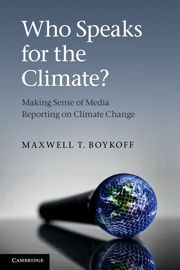5 - Climate stories How journalistic norms shape media content
Published online by Cambridge University Press: 05 June 2012
Summary
The previous two chapters mapped out elements shaping how mass media have represented complexity and nuance. It is critically important to look at how both the issues themselves as well as the surrounding contextual factors shape media representations of climate change. This expanded assessment of the networks or webs within which these issues emerge helps to then more capably appraise how and why certain climate issues find traction. Large-scale social, political and economic factors (such as shrinking newsrooms and fewer specialist journalists covering environmental issues) influence everyday individual journalistic decisions (such as how to focus or frame a story with limited time to press as well as a finite number of column inches).
Together, constructions of meaning – negotiated in the spaces of cultural politics – are shaped by structural and institutional as well as cultural and psychological factors, operating simultaneously at multiple scales. These issues intersect with journalistic norms and values. Over the last century, there have been numerous examinations of how journalistic ‘norms’ and ‘values’ influence story narratives (e.g. Galtung and Ruge, 1965; Wilkins, 1993). However, fewer studies have linked this work with how mass media have portrayed issues of climate science, policy and politics.
- Type
- Chapter
- Information
- Who Speaks for the Climate?Making Sense of Media Reporting on Climate Change, pp. 99 - 120Publisher: Cambridge University PressPrint publication year: 2011



